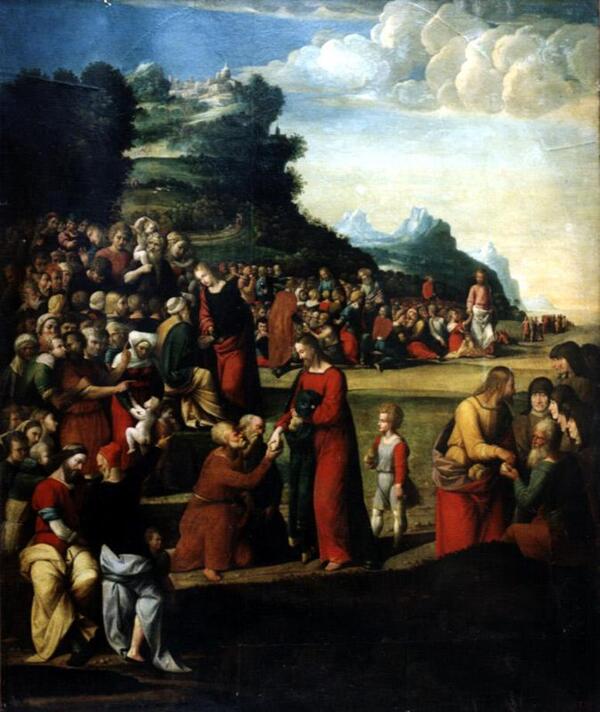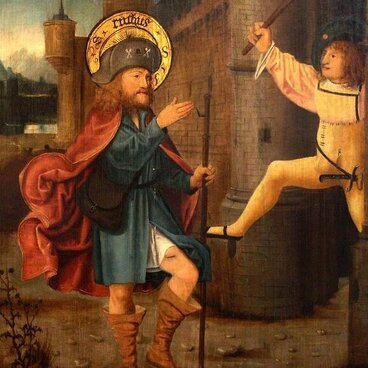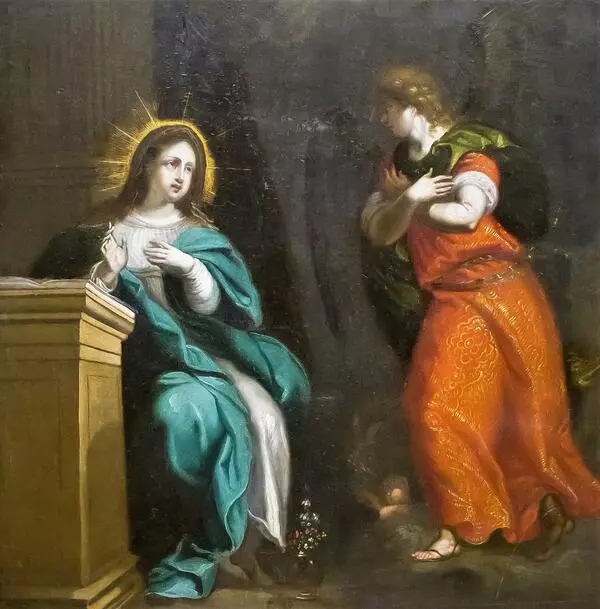The Italian painter Benvenuto Tisi was nicknamed Garofalo, either because of the place his family came from or because he had a carnation flower (garofano in Italian) on his family coat of arms, but this is the name under which he went down in the history of painting.
Garofalo was born in Ferrara at the end of the 15th century. He studied painting in various studios in Bologna, Cremona and Rome. It was in Rome that Tisi met and became friends with the great Raphael, which had a profound influence on Garofalo’s painting: the style of the Ferrarese became more classical and stylized. At the same time, the freshness and grace of Tisi’s early works were preserved, while the manner of painting became even more beautiful thanks to the added refinement, soft exquisite forms, and lively colors.
In 1512 Garofalo returned to his native Ferrara, where he worked on numerous commissions for local churches. The painting “Feeding the Multitude” was created by Garofalo on a Gospel subject. It was painted in the 1520-1530s when the artist, who had gone blind in one eye, was working in the monastery of San Bernardino, having taken a vow to work pro bono in the hope of being healed. The work is based on the legend about the miracle of feeding five thousand people: the large crowd that followed Jesus was then fed with five loaves and two fish.
This work by Garofalo shows an undeniable influence of Raphael, for example, in depicting John the Evangelist. John is often portrayed as a gentle young man with feminine features. Here he resembles Raphael’s young blond beauties with their regular features and he can easily be identified among the other disciples of Christ and the pilgrims.
The painting is executed in very lively broad brushstrokes. Christ distributes food to the Apostles, and some of them, having starved, eat it. Garofalo portrayed his mother, the abbess, other nuns, and apparently his three daughters among them. The introduction of the nuns into the Gospel story is not accidental — it is a reminder of the charitable activities of the monastery. And the elder figure, as art historians believe, may be a self-portrait. Such communication with the viewer was a frequent artistic technique in painting of that period.
Garofalo was born in Ferrara at the end of the 15th century. He studied painting in various studios in Bologna, Cremona and Rome. It was in Rome that Tisi met and became friends with the great Raphael, which had a profound influence on Garofalo’s painting: the style of the Ferrarese became more classical and stylized. At the same time, the freshness and grace of Tisi’s early works were preserved, while the manner of painting became even more beautiful thanks to the added refinement, soft exquisite forms, and lively colors.
In 1512 Garofalo returned to his native Ferrara, where he worked on numerous commissions for local churches. The painting “Feeding the Multitude” was created by Garofalo on a Gospel subject. It was painted in the 1520-1530s when the artist, who had gone blind in one eye, was working in the monastery of San Bernardino, having taken a vow to work pro bono in the hope of being healed. The work is based on the legend about the miracle of feeding five thousand people: the large crowd that followed Jesus was then fed with five loaves and two fish.
This work by Garofalo shows an undeniable influence of Raphael, for example, in depicting John the Evangelist. John is often portrayed as a gentle young man with feminine features. Here he resembles Raphael’s young blond beauties with their regular features and he can easily be identified among the other disciples of Christ and the pilgrims.
The painting is executed in very lively broad brushstrokes. Christ distributes food to the Apostles, and some of them, having starved, eat it. Garofalo portrayed his mother, the abbess, other nuns, and apparently his three daughters among them. The introduction of the nuns into the Gospel story is not accidental — it is a reminder of the charitable activities of the monastery. And the elder figure, as art historians believe, may be a self-portrait. Such communication with the viewer was a frequent artistic technique in painting of that period.




